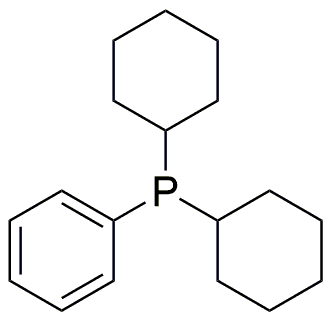Dicyclohexylphenylphosphine is widely utilized in research focused on:
- Catalysis: This compound serves as a ligand in various catalytic processes, enhancing the efficiency of reactions in organic synthesis, particularly in transition metal catalysis.
- Pharmaceutical Development: It plays a role in the development of new drugs by facilitating the synthesis of complex organic molecules, making it valuable in medicinal chemistry.
- Material Science: Dicyclohexylphenylphosphine is used in the creation of advanced materials, including polymers and composites, due to its ability to modify properties and improve performance.
- Electronics: This chemical is applied in the production of electronic components, where it helps in the development of phosphine-based materials that enhance conductivity and stability.
- Environmental Chemistry: It is utilized in the study of environmental pollutants, aiding researchers in understanding and mitigating the effects of phosphine derivatives in ecosystems.
General Information
Properties
Safety and Regulations
Applications
Dicyclohexylphenylphosphine is widely utilized in research focused on:
- Catalysis: This compound serves as a ligand in various catalytic processes, enhancing the efficiency of reactions in organic synthesis, particularly in transition metal catalysis.
- Pharmaceutical Development: It plays a role in the development of new drugs by facilitating the synthesis of complex organic molecules, making it valuable in medicinal chemistry.
- Material Science: Dicyclohexylphenylphosphine is used in the creation of advanced materials, including polymers and composites, due to its ability to modify properties and improve performance.
- Electronics: This chemical is applied in the production of electronic components, where it helps in the development of phosphine-based materials that enhance conductivity and stability.
- Environmental Chemistry: It is utilized in the study of environmental pollutants, aiding researchers in understanding and mitigating the effects of phosphine derivatives in ecosystems.
Documents
Safety Data Sheets (SDS)
The SDS provides comprehensive safety information on handling, storage, and disposal of the product.
Product Specification (PS)
The PS provides a comprehensive breakdown of the product’s properties, including chemical composition, physical state, purity, and storage requirements. It also details acceptable quality ranges and the product's intended applications.
Certificates of Analysis (COA)
Search for Certificates of Analysis (COA) by entering the products Lot Number. Lot and Batch Numbers can be found on a product’s label following the words ‘Lot’ or ‘Batch’.
*Catalog Number
*Lot Number
Certificates Of Origin (COO)
This COO confirms the country where the product was manufactured, and also details the materials and components used in it and whether it is derived from natural, synthetic, or other specific sources. This certificate may be required for customs, trade, and regulatory compliance.
*Catalog Number
*Lot Number
Safety Data Sheets (SDS)
The SDS provides comprehensive safety information on handling, storage, and disposal of the product.
DownloadProduct Specification (PS)
The PS provides a comprehensive breakdown of the product’s properties, including chemical composition, physical state, purity, and storage requirements. It also details acceptable quality ranges and the product's intended applications.
DownloadCertificates of Analysis (COA)
Search for Certificates of Analysis (COA) by entering the products Lot Number. Lot and Batch Numbers can be found on a product’s label following the words ‘Lot’ or ‘Batch’.
*Catalog Number
*Lot Number
Certificates Of Origin (COO)
This COO confirms the country where the product was manufactured, and also details the materials and components used in it and whether it is derived from natural, synthetic, or other specific sources. This certificate may be required for customs, trade, and regulatory compliance.


